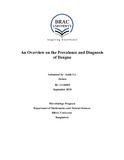| dc.contributor.advisor | Hossain, Mahboob | |
| dc.contributor.author | Ashik-Uz- Zaman | |
| dc.date.accessioned | 2018-12-02T06:52:59Z | |
| dc.date.available | 2018-12-02T06:52:59Z | |
| dc.date.copyright | 2018 | |
| dc.date.issued | 2018-09 | |
| dc.identifier.other | ID 11126005 | |
| dc.identifier.uri | http://hdl.handle.net/10361/10925 | |
| dc.description | This thesis is submitted in partial fulfilment of the requirements for the degree of Bachelor of Science in Microbiology, 2018. | en_US |
| dc.description | Catalogued from PDF version of thesis report. | |
| dc.description | Includes bibliographical references (page 32-39). | |
| dc.description.abstract | Dengue viral contamination has become greater in size, global health concern with over twofifths
of the world's population at risk of infection. This paper provides a brief review of the
history of dengue research. It is the most rapidly laying out measure borne disease, attributed
to changing demographics, urbanization, environment, and global travel. It continues to be an
intimidating remark in over 100 tropical and sub-tropical countries, affecting predominantly
children. Dengue also carries a hefty financial burden on the health care systems in affected
areas, as those infected seek care for their symptoms. The search for a suitable vaccine for
dengue has been ongoing for the last sixty years, yet any effective treatment or vaccine
remains elusive. A vaccine must be safeguarded for all four serotypes of dengue and be costeffective.
Many proceed towards to developing, candidate vaccines have been employed. The
candidates incorporate live weakened tetravalent vaccines, chimeric tetravalent vaccines
based on attenuated dengue virus or Yellow Fever 17D, and recombinant DNA vaccines
based on flavivirus and non-flavivirus vectors. Dengue viruses spread the disease to nearly
100 million human beings each year living in 110 countries spread over all tropical areas on
earth. Tens of millions of dengue illnesses occur annually including the hundreds of
thousands of children who are hospitalized for dengue hemorrhagic fever. A health problem
of this scope should be regarded as a high priority and should have attracted ample funding
from donors and national authorities. But such is not the case. A brief historical review
reveals that there was a greater number of laboratories and a greater allocation of resources to
dengue research 30-50 years ago than there is today. WHO needs to provide leadership in
promoting dengue research. Each and every dengue-endemic country should realize the fact
that a sustained research capability is crucial to resolve the long-term ongoing problem of
dengue control(1). | en_US |
| dc.description.statementofresponsibility | Ashik-Uz-Zaman | |
| dc.format.extent | 39 pages | |
| dc.language.iso | en | en_US |
| dc.publisher | BRAC University | en_US |
| dc.rights | BRAC University theses are protected by copyright. They may be viewed from this source for any purpose, but reproduction or distribution in any format is prohibited without written permission. | |
| dc.subject | Dengue | en_US |
| dc.subject.lcsh | Dengue | |
| dc.subject.lcsh | Immunology | |
| dc.title | An overview on the prevalence and diagnosis of dengue | en_US |
| dc.type | Thesis | en_US |
| dc.contributor.department | Department of Mathematics and Natural Sciences, BRAC University | |
| dc.description.degree | B. Microbiology | |

